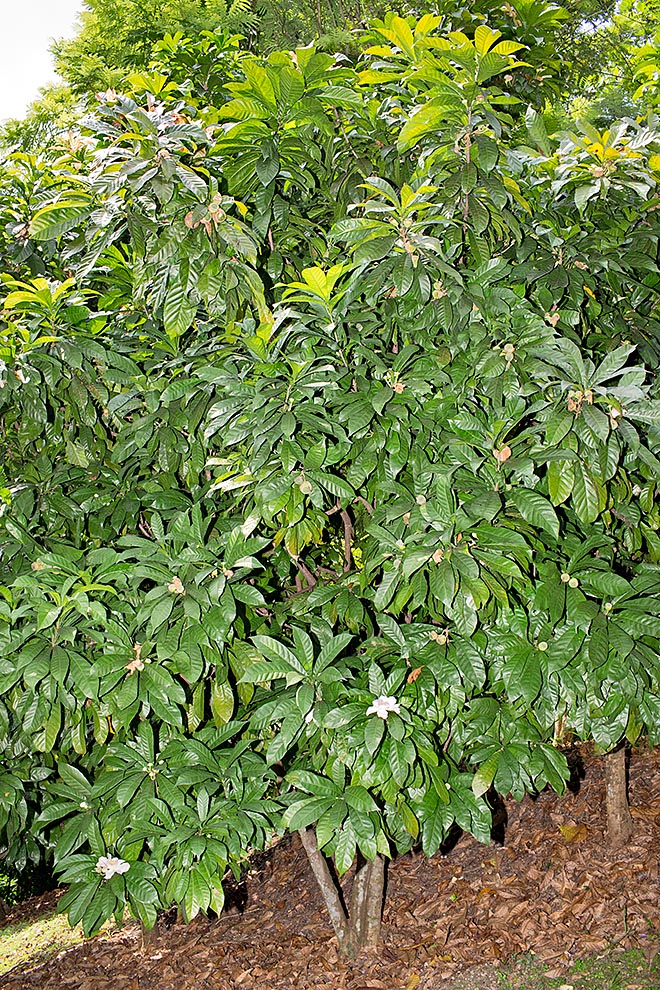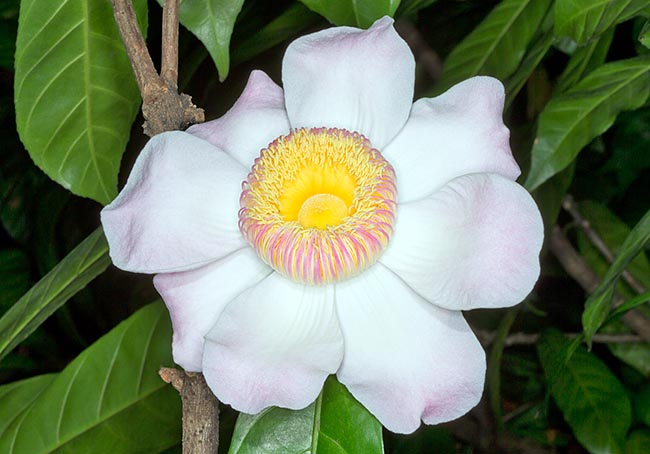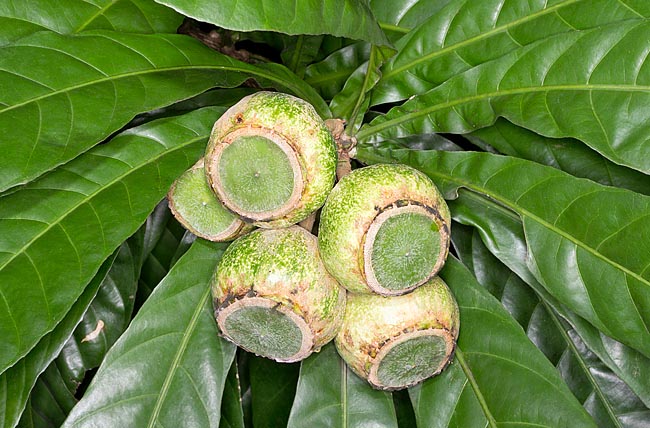Family : Lecythidaceae

Text © Pietro Puccio

English translation by Mario Beltramini

Native to Panama, Colombia and Ecuador, Gustavia superba is a 5-10 m small tree © Giuseppe Mazza
The genus was honoured by Linnaeus to the King of Sweden Gustav III (1746-1792), his patron; the name of the species is the Latin adjective “superbus, a, um” = superb, magnificent, with obvious reference.
Common names: heaven lotus, monkey fruit (English); membrillo, membrillo hembra, pacó, pacora, sachamango (Spanish).
The Gustavia superba (Kunth) O.Berg (1856) is a little ramified evergreen tree with erect trunk with greyish bark, 5-10 m tall and of 10-20 cm of diameter.
The leaves, on short petiole, are simple, alternate, coriaceous, concentrated at the apices of the branches, of oblong-oblanceolate shape with abruptly pointed apex, up to 0,8-1 m long and 25 cm broad, with slightly indented margin, glabrous, of brown colour in the young leaves, then dark green.
Inflorescences in short corymbs directly from the trunk or from the main branches carrying few flowers, on an about 8 cm long pedicel, of 12-15 cm of diameter, with 6-10 unequal obovate petals, 5-6 cm long and 3,5 cm broad, of colour varying from white to cream white at times with crimson pink hues, and numerous stamina, pinkish on top, about 4 cm long, fused for one third of their length to form a yellowish fleshy ring; the flowers are pollinated by the bees and by bats.
The fruit is a pyxis (dried fruit where, when ripe, a sort of cover called operculum detaches on top), globular-depressed with a prominent ring at the apex, about 8 cm long and up to 10 cm broad, green tending yellow and orange, often with rather unpleasant smell when ripe, containing an average of 7 brown irregularly shaped seeds, 1-4 cm long, with orange edible fleshy aril. The fruits are a food for primates, in particular for the Cebus capucinus (Linnaeus, 1758), rabbits, rodents, squirrels and other small animals which contribute to the dispersion of the seeds.

The splendid flowers touch the 15 cm. Stamina, fused at the base, form a fleshy ring © Giuseppe Mazza
Species of tremendous ornamental value, due to its foliage and especially to its huge flowers, diffused in the origin zones, where it is often cultivated in the family gardens for its fruits, but little known elsewhere.
Cultivable in the humid tropical and subtropical climate zones on well drained soils rich of organic substance, acidic or neutral, kept almost constantly humid, but without stagnations, in full sun or slight shade and sheltered from the winds.
Where the climate does not allow the permanence in open air during the winter months it can be cultivated in capacious containers, where it may even flower, in order to be sheltered in spacious and luminous greenhouses or in winter gardens, utilizing an organic loam with addition of siliceous sand or agri-perlite for a 30% to improve the drainage; the ambient humidity as well as the temperatures should be on average high, with lowest values for these last never under 15 °C.

The fruit is an even 10 cm broad pyxis. The aril surrounding the seeds is edible © Giuseppe Mazza
Watering must be regular during the summer, more spaced in winter, but without allowing the loam to dry up completely. The fertilizations, during the vegetative period, must be done preferably with slow releasing balanced products with addition of microelements. The aril surrounding the seeds, nourishing and with high contents of fats, phosphorus and vitamin A, is consumed raw or, more frequently, added to various dishes (soups, rice, meats, etc.), to which it confers particular colour and taste.
The wood has fairly good characteristics of hardness, resistance and workability and has limited utilization in the constructions.
Synonyms: Pirigara superba Kunth (1825); Pirigara insignis Kunth ex Hemsl. (1880); Japarandiba superba (Kunth) Kuntze (1891).
→ To appreciate the biodiversity within LECYTHIDACEAE family please click here.
